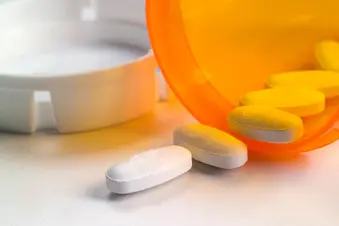
Eosinophilic esophagitis (EoE) is a rare inflammatory disease of the esophagus, the tube that connects your mouth to your stomach. If you have EoE, a type of white blood cell known as an eosinophil builds up in your esophagus, causing injury and inflammation. This may make it hard for you to eat and swallow. EoE can make it hard for kids to get proper nutrition and lead to poor growth. It can also cause chronic pain.
While there’s no cure for eosinophilic esophagitis (EoE), there are several medications doctors prescribe to control symptoms, ease inflammation, and prevent further damage. These often work best if they’re used along with dietary changes to avoid foods that may worsen the condition.
Here’s a look at what’s available, as well as a peek into what treatments may emerge in the future.
Proton pump inhibitors (PPIs). These are often the first medications doctors use to treat EoE. Their main use is to keep stomach acid out of the esophagus in people who have acid reflux, but they can also reduce inflammation. This may be because the disease is similar to reflux – or often comes along with it.
To start, you’ll take a full dose of a PPI once a day for 8 weeks. If your symptoms aren’t better after about a month, you take a full dose twice a day. When 2 months are up, your doctor will check again to see if your symptoms have improved.
The doctor may do a follow-up test called an upper endoscopy to check the number of eosinophils and the level of inflammation. They’ll use a camera on the end of a long tube to take a look at the inside of your esophagus.
Or they may just ask you about your symptoms to decide if the PPIs have worked. Most of the time, if you feel like you’ve improved, your doctor will continue the PPI at the lowest dose possible to control your symptoms.
Corticosteroids. Although these meds aren’t formally approved to treat EoE, they help control the inflammation that may worsen the condition. Most patients respond well to this treatment.
There are two main types of steroids your doctor may use:
- Fluticasone. You’ll spray this medication into your mouth and then swallow it. You can’t breathe in while you get a dose, and you can’t eat or drink for 30 minutes afterward. People usually take about four to eight sprays over the course of the day.
Fluticasone usually works quickly – within a week, or even as soon as 1 to 2 days. After about 4 to 8 weeks, your doctor will recheck your symptoms. If you’re better, they’ll do another upper endoscopy to make sure your inflammation is going down. Once you’ve had a good response, the doctor will lower your dose to a maintenance level – for example, four sprays daily, instead of eight.
- Budesonide. If you don’t respond to fluticasone, your doctor may suggest this steroid instead. It comes in the form of a “semi liquid” that you swallow. You mix it yourself, with something like honey, applesauce, or Splenda, to make it thick enough so that it coats your esophagus as you swallow it. You need to drink it slowly, over 5 to 10 minutes. Once you’re done, rinse your mouth out with water and spit, to reduce chances that you’ll get a yeast infection. You can’t eat or drink anything for about an hour afterward.
You should feel better within a few days. Your doctor will check you again after about 12 weeks on this treatment. If you feel better, you’ll get another upper endoscopy to make sure it’s working.
If you don’t respond to either corticosteroid, your doctor may try other steroid options such as ciclesonide or mometasone furoate. Small studies show both treatments may help.
While all of these drugs do work, you need to take them every day to see benefits. Once you stop, your symptoms will come back.
Dupilumab (Dupixent). This new drug is a type of medication called a monoclonal antibody, or biologic. It acts on the inflammation that causes eosinophils to grow in your esophagus. You take it once a week as a shot. In studies, about 60% percent of people with EoE who took it responded to treatment. It led to a significant reduction in common EoE symptoms like trouble swallowing. It’s the first drug approved just for EoE, and adults and children over 12 who weigh at least 88 pounds can take it.
Show Sources
Photo Credit: jcphoto / Getty Images
SOURCES:
UpToDate: “Treatment of Eosinophilic Esophagitis.”
News Release, FDA.
FDA: Tertiary Pharmacology/Toxicology Review, Fasenra (benralizumab).
American Academy of Allergy, Asthma & Immunology: “Eosinophilic Esophagitis: Symptoms, Diagnosis & Treatment.”
American Partnership for Eosinophilic Disorders: “Eosinophilic Esophagitis.”
Mayo Clinic: "Upper endoscopy."
Gastroenterology Clinics of North America: "Steroids in Pediatric Eosinophilic Esophagitis."
National Jewish Health: "Treatment of EoE with Oral Viscous Budesonide."
Frontiers in Physiology: “Interleukin-5 in the Pathophysiology of Severe Asthma.”